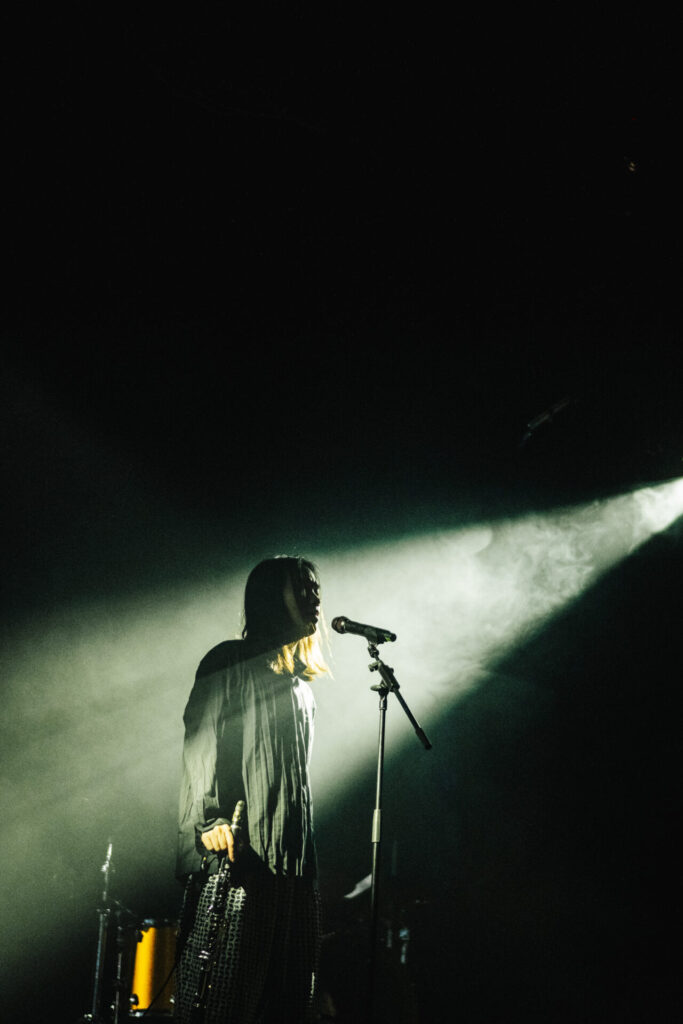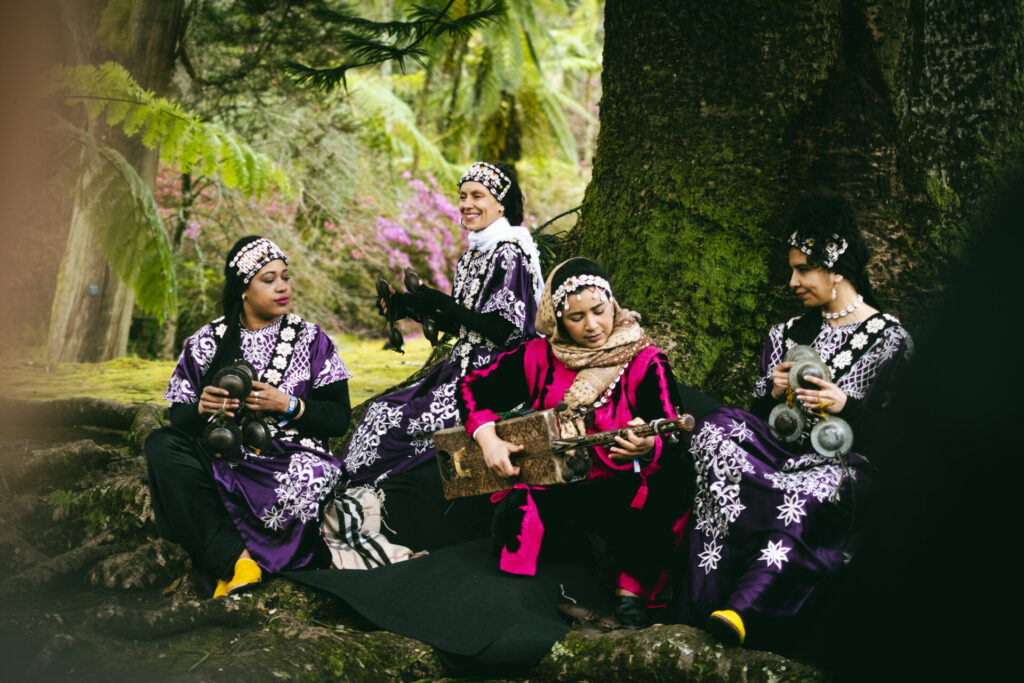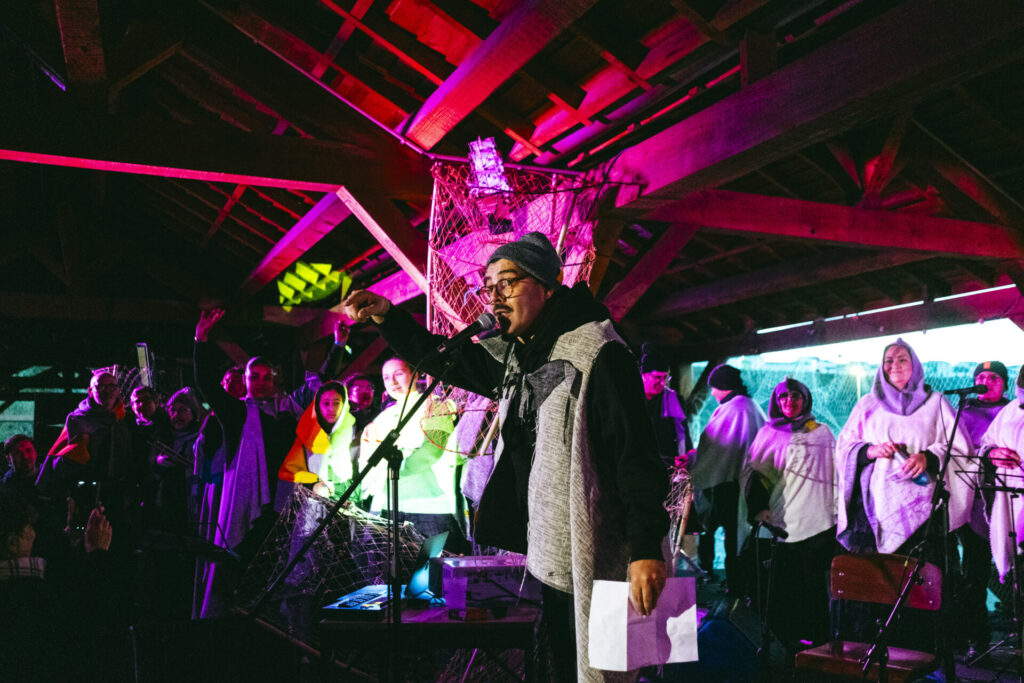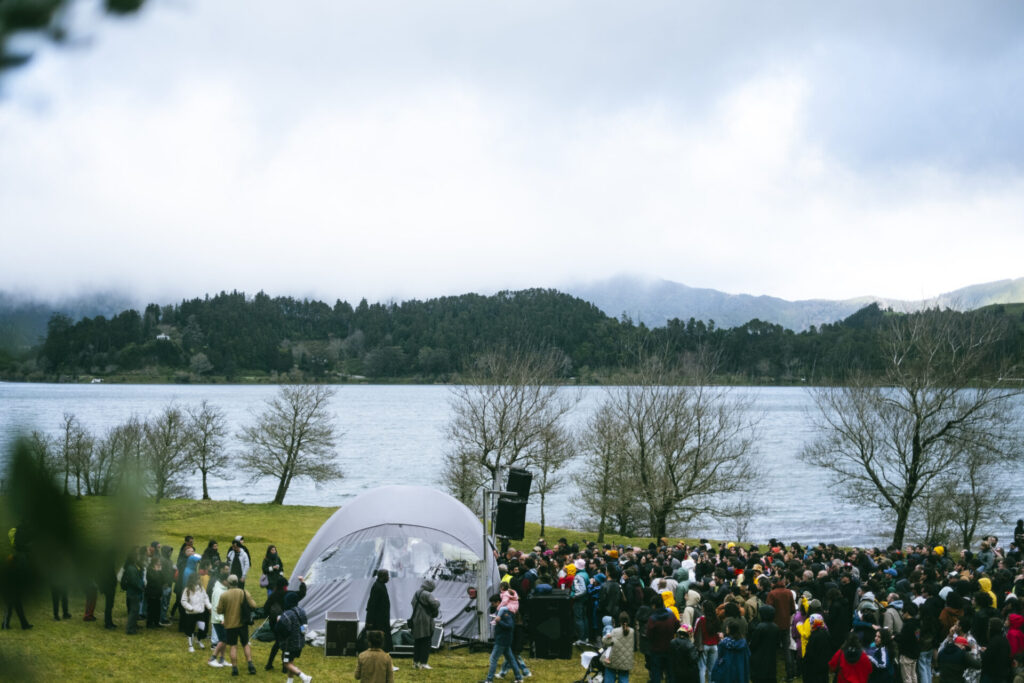It’s impossible to disentangle Tremor Festival from the island on which it takes place, São Miguel, the largest of The Azores. Just as the programming of the festival puts an impetus on adventurousness and the dissolving of arbitrary boundaries, purposefully fostering disorientation in a number of different ways, so too does flux feel innate to the island. Historically, it’s been a place of comings and goings rather than settlings, thanks to its location in the middle of the Atlantic. In centuries past it was a convenient stop off for sailors in the middle of longer voyages, and for pirates seeking a quick plunder. In the Second World War, neutral Portugal cut a deal allowing the Allies to raise temporary military hospitals, whole sprawls of tents and shacks filled with death, pain and drama for just a few short years, returned to the ether as soon as the war was done. Today Ponta Delgada, the island’s capital, is dominated by a new transitionary population – the inhabitants of the enormous mega cruise ships that arrive overnight, looming over the harbour, vanishing entirely by the following evening as if a mirage.
Weather forecasts have no power here. Rain can give way to sunshine then back again within a couple of minutes; to spend a day here is to be constantly zipping, unzipping, zipping and unzipping your raincoat, donning and removing your sunglasses. There are mysterious forces at work. I remark to a Portuguese musician that 15-minute walks between venues in the city can sometimes feel like an hourlong trek, and at others like a nip round the corner, and he smiles with recognition. “It’s psychedelic here for sure. There’s a lot of magic on these islands, and you’re picking up on it.”
For the most part festivalgoers at Tremor aren’t allowed to settle too long in one venue as they wander around Ponta Delgada. Most host one show of around 45 minutes per day, forcing a sense of constant movement, turning the gigs into little islands of their own. As diverse as the music played within them, settings include a converted 1950s cinema, an 18th century church lined with gold, a little upstairs social club lined with varnished pine, a century-old traditional concert hall that’s the largest venue in the Azores, and a music school auditorium.
It’s in the latter that tQ encounters perhaps the best set of the week in the form of FIRE!, the trio of Mats Gustafsson, Johan Berthling and Andreas Werlin. Beginning with a lolloping beat of Werlin’s skittering drums and Berthling’s grounding bass, Gustafsson cuts through the groove intermittently with quick blasts of his baritone saxophone. Gradually, melodies begin to emerge from the squalls: a note divides into two, then again, until before you know it all three musicians are locked into a relentless multidimensional groove. Gustafsson starts alternating between saxophone and flute, playing the latter with a jagged intensity, blowing so sharp and so hard that he’s almost howling into the mouthpiece. After one sequence when the band are moving with such intensity that they’re on the verge of collapsing under their own momentum, they ease back, perfectly timed, into a period of slow and absorbing gloom, Gustafsson here making a harmonica sound like a rusty pipe, Berthling’s bass plunging down into doom metal depths.
Berlin-based 33 run FIRE! close when it comes to quality. Headed by experimental musician Alexander Iezzi and performance artist/composer Billy Bultheel, they are an amorphous cross-disciplinary project who alter their approach to each performance depending on circumstances, as well as their lineup. Here, Sydney-born artist Ivan Cheng makes them a trio, who stand on platforms that elevate them slightly higher than the stage, lit by piercing white beams. The music they produce from that height is dazzling in its fluidity – a potent stew of Bultheel’s heavy drones, Cheng’s haunting clarinet, Iezzi’s clobbering machine gun drums, distorted waterphone drones, club tracks deconstructed into piercing squalls.

All three sing at different times, Bultheel’s voice is moody and low, Iezzi’s warped via cheeky electronic manipulation, while it’s Cheng – stood centre stage – who is the most magnetic of all, shifting relentlessly from scorching screams to heavenly choral swoops, sometimes within the same breath. He moves sinuously as he does so, leaping and crouching and jerking and falling along with the music’s expertly controlled shifts in momentum, its total beauty and its torrential troughs. At one point, using two microphones at once, he embodies both extremes simultaneously, while Bultheel circles him in the gloom wielding – to surprisingly powerful effect – flashing handheld torches.
It makes a good illustration of Tremor’s constant disorientation that immediately after the second their sets, we move straight from the sublime of 33 to the outright ridiculousness of Joseph Keckler, who sings in traditional – and stunning – operatic tradition, but whose subject matter veers frequently into absurdist comedy. There is a lengthy and meandering song about fucking a ghost, for instance, another about spending so much money on vinyl clothing that it derails one’s career. Beautiful in sound, deeply silly in content, the juxtaposition between the two is delightfully disarming. In the same venue, the Teatro Micaelense, on an earlier night, Keeley Forsyth fills the room with an entirely opposite energy. Although she also deploys operatic vocals, the similarities between her and Keckler end there; Forsyth’s set delivers darkness in an unflinching sense, a thick cloud that remains unbroken by any light. Drawing as much from her parallel career in acting and early training in dance, she moves in distinct, expressionistic gestures, circling a sole wooden chair. In this context, the absence of anyone sitting in it speaks volumes.
Forsyth isn’t the only artist at Tremor who crosses the boundaries between different disciplines. At the multipurpose dockside space Portas do Mar – the closest thing Tremor has to a central hub, hosting the majority of its after-dark programming – Parisian Oko Ebombo also plays a set heavily informed by dance. While Forsyth directs the energy inwards, however, Ebombo’s show looks defiantly, euphorically outward. A dance teacher from the age of 12, (as well as a poet, photographer and performance artist), he’s intensely charismatic – demanding “kinky, kinky Parisian vibes” from his obliging audience as he provides a winning combination of psychedelia-tinged hip hop and soul.
The back room at Portas Do Mar, meanwhile, is given over to DJ programming, the most notable of which comes from Anita Nemet and her son Olan – who, by the way, is just 10 years old. Beginning with Anita crouched on the dancefloor, delivering stirring vocalisations while Olan helms a low throb of unsettling bass, they reunite behind the decks for a set that’s utterly dizzying, shifting from rapid-fire drum & bass into psychedelic jazz into trip hop into EBM into techno into abstracted folk singing into colossal dub plunges into ethereal pop.

In Ponta Delgada we are also treated to a rousing set of traditional Azorean music from Romeu Bairos, a more experimental approach to Portuguese folk from the immensely engaging Ana Lua Caiano, who blends it with a cutting electronics, and a hyperpop/punk rock/cello crossover from Argentina’s Blanco Teta in Portas Do Mar. The same venue sees the debut performance from a crew of local young rappers and beatmakers who have been put together under the stewardship of Lisbon hip hop heavyweight Xullaji especially for the festival. The ever-shifting energy of the capital, however, is not all that Tremor has to offer.
A large part of the festival’s programming takes place during field trips – coach journeys arranged to the island’s outer reaches. Where exactly they take you and what exactly you find when you get there is naturally, given that overriding theme of disorientation, kept hidden. On the many drives through the island’s great peaks and valleys – the result of its volcanic origin – Sao Miguel is again revealed to be an island whose energy is ever shifting. Cow-peppered fields giving way to plunging cliffs; magnificent subarctic-like lakes to sprawls of lush vegetation better suited to the tropics.
tQ finds space for three such trips across our five days in Sao Miguel. The first takes us to Terra Nostra, a nature park that surrounds a thermal pool fed by a volcanic spring. Walking from the coach up winding paths, rhythm can be heard in the distance that grows louder as we progress, until after turning one final corner the Moroccan gnawa musician Asma El Hamzaoui and her band Bnat Timbouktou are revealed as the source. After a brief performance on the spot, a hypnotic loop of percussion and group vocals, they start to walk deeper into the woods, still singing as they do so. After a short while we pause for El Hamzaoui swaps from drum to sintir, a three-stringed lute, and then after another static performance venture deeper still until we come to the springs, where they depart and leave us for a swim. The second trip takes us to another body of water, Lagoa Das Furnas, a stunning volcanic crater-lake. Here, a previously-unannounced performer, in this case the Belgian self-professed “prehistoric techno” outfit Why The Eye. Their brand of up-tempo motoric psych is immensely enjoyable, although they play second fiddle to their surroundings, although most artists, it’s fair to say, would be upstaged by perhaps Sao Miguel’s most stunning landscape of all.

The third of our trips, meanwhile, is the most disorienting of all, a magical mystery tour that takes us first to Maia, a small parish out in the island’s rural north, where a former tobacco factory and now museum overlooks a particularly rugged stretch of coastline. Here, Glaswegian sibling noise punk duo Comfort are another of Tremor’s ‘secret’ acts, and still sound-checking when our bus arrives, having got to the Azores, they tell us, literally an hour before they were due to play. As a result takes them a few minutes to blow away the cobwebs but when they get going the pair’s energy is properly ferocious. Vocalist Natalie McGhee is another of the week’s acts whose performance draws heavily on the kinetic, but where Forsyth’s movements were dark and calculated, Ebombo’s bright and exuberant, McGhee’s are brilliantly scrappy, leaping atop speakers and into the crowd, twisting and contorting as she rattles through fervent and uncompromising material that draws heavily from the political and her experience as a trans woman.
Halfway through Comfort’s set, in search of a bathroom I get lost and find myself in one of the museum exhibits and begin reading about different methods of curing tobacco, the band’s pummelling noise still audible in the background. This is only to be the first of the day’s many curious juxtapositions, however. Next, the bus drives us for a quick stop in the village of Ribeira Grande, where we’re led to a local food hall. Here, we are treated to a manic set from Portuguese trio 800 Gondomar, a deeply engaging no-nonsense blend of noise, punk and garage rock. Judging by the intensity of the mosh that breaks out among the plastic café tables, they are local favourites, even if a few passing families in search of lunch look on with bafflement.
Then, the bus again, this time to Rabo de Peixe, a small fishing community just down the road. We walk steeply downhill to the docklands, past terraced houses that each bear a portrait of a different saint on their front walls, past still-in-use fish houses, to the docks. Against one wall of a small hut belonging to the local naval club, parrotfish soup, tapas and tuna burgers are being distributed to hungry punters, while on the other is an anarchic set by Rabo de Peixe-born filmmaker Diogo Lima under his alias DJ Gaivota (DJ Seagull in English) and members of the wider island nightlife scene, that feels like a take on what I imagine an Azorean school disco to feel like – a mash-up of unabashed party tunes, glossy Latin pop and, at one point, ‘La Macarena’.

Then, in a larger hut a hundred yards away, we find the week’s most beautiful set of all. Som Sim Zero, a sprawling group drawn from members of the island’s Deaf Association, the art collective Ondamarela and a number of local initiatives, has been invited by Tremor to respond directly to the work of the much-loved Portuguese poet Adília Lopes, and to wider themes of the sky and the sea. They do so in immensely moving fashion, a mixture of choral singing, psychedelic grooves, exuberant shanties and spoken word. Once again, this time by nature of my not knowing the language, the festival has evoked an element of confoundment into my experience, and once again this has forced me to rely not on cold analysis but on base emotion. In this case, it allows the absolute joy of this performance to travel straight to my unguarded core. As so often across the week, Tremor proves that disorientation is to be cherished.
Tremor Festival’s next edition will take place from 24 to 28 March 2026


